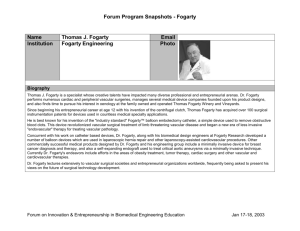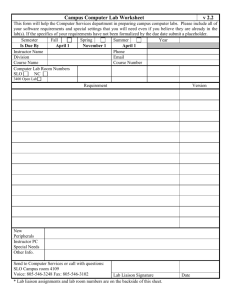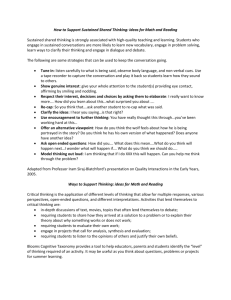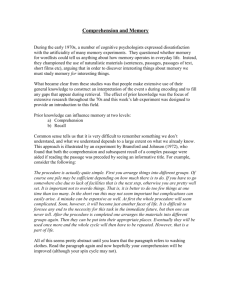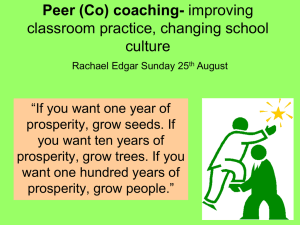Seven-Keys-to-Effective-Professional
advertisement
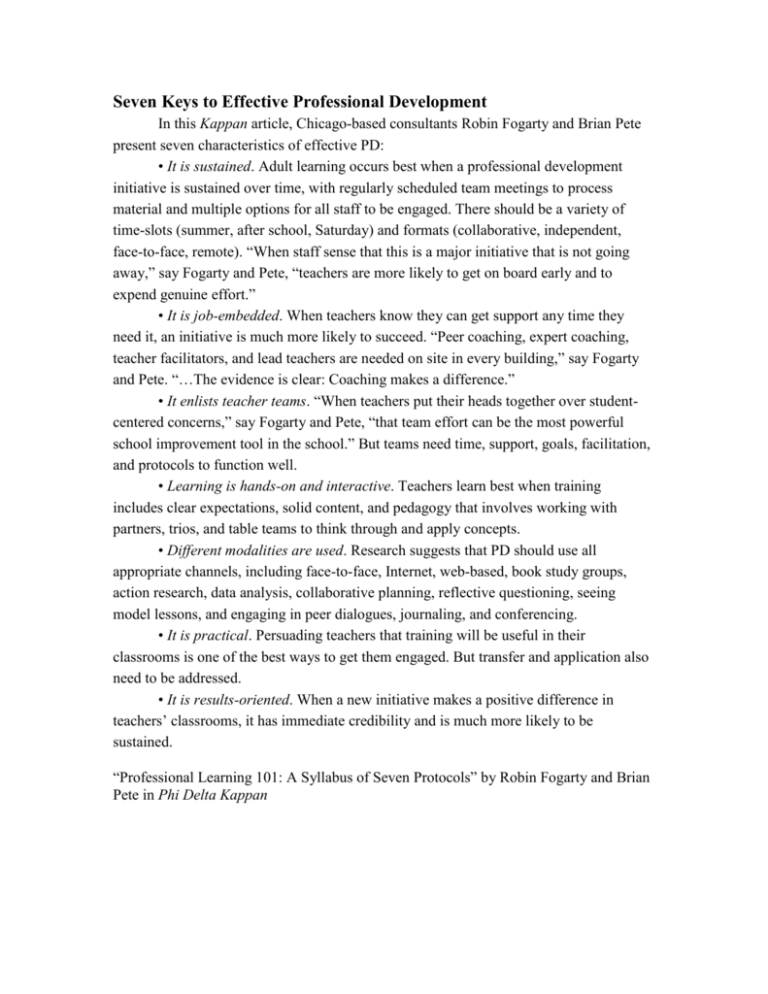
Seven Keys to Effective Professional Development In this Kappan article, Chicago-based consultants Robin Fogarty and Brian Pete present seven characteristics of effective PD: • It is sustained. Adult learning occurs best when a professional development initiative is sustained over time, with regularly scheduled team meetings to process material and multiple options for all staff to be engaged. There should be a variety of time-slots (summer, after school, Saturday) and formats (collaborative, independent, face-to-face, remote). “When staff sense that this is a major initiative that is not going away,” say Fogarty and Pete, “teachers are more likely to get on board early and to expend genuine effort.” • It is job-embedded. When teachers know they can get support any time they need it, an initiative is much more likely to succeed. “Peer coaching, expert coaching, teacher facilitators, and lead teachers are needed on site in every building,” say Fogarty and Pete. “…The evidence is clear: Coaching makes a difference.” • It enlists teacher teams. “When teachers put their heads together over studentcentered concerns,” say Fogarty and Pete, “that team effort can be the most powerful school improvement tool in the school.” But teams need time, support, goals, facilitation, and protocols to function well. • Learning is hands-on and interactive. Teachers learn best when training includes clear expectations, solid content, and pedagogy that involves working with partners, trios, and table teams to think through and apply concepts. • Different modalities are used. Research suggests that PD should use all appropriate channels, including face-to-face, Internet, web-based, book study groups, action research, data analysis, collaborative planning, reflective questioning, seeing model lessons, and engaging in peer dialogues, journaling, and conferencing. • It is practical. Persuading teachers that training will be useful in their classrooms is one of the best ways to get them engaged. But transfer and application also need to be addressed. • It is results-oriented. When a new initiative makes a positive difference in teachers’ classrooms, it has immediate credibility and is much more likely to be sustained. “Professional Learning 101: A Syllabus of Seven Protocols” by Robin Fogarty and Brian Pete in Phi Delta Kappan What the research says is effective in professional development • Effective professional development is intensive, ongoing, and connected to practice. It focuses on the teaching and learning of specific academic content, is connected to other school initiatives, and builds strong working relationships among teachers. Occasional workshops on discrete topics do not cut it! PD is most effective “when it addresses the concrete, everyday challenges involved in teaching and learning specific academic subject matter,” write the authors, “rather than focusing on abstract educational principles or teaching methods taken out of context. Equally important, professional development that leads teachers to define precisely which concepts and skills they want students to learn – and to identify the content that is most likely to give students trouble – has been found to improve teacher practice and student outcomes.” • Collaborative approaches to professional learning can promote improvements that extend beyond individual classrooms. “When all teachers in a school learn together,” say the authors, “all students in the school benefit.” This means it’s essential to carve out meeting time for department and grade-level teams and across levels. • Sustained and intensive professional development for teachers correlates with gains in student achievement. For example, 49 hours of PD in a school year boosts student achievement by 21 percent. “Sustained” is defined as between 30 to 100 hours a year. “State of the Profession: Study Measures Professional Development” by Linda DarlingHammond, Ruth Chung Wei, Althea Andree, Nikole Richardson, and Stelios Orphanos in Journal of Staff Development, Spring 2009 (Vol. 30, #2, p. 42-50), no e-link available; the full report, Professional Learning in the Learning Profession: A Status Report on Teacher Development in the United States and Abroad, is available at http://www.nsdc.org/news/NSDCstudy2009.pdf.

